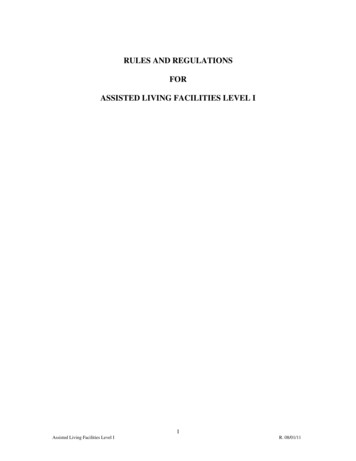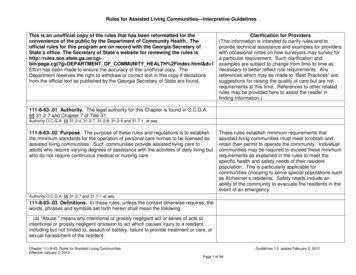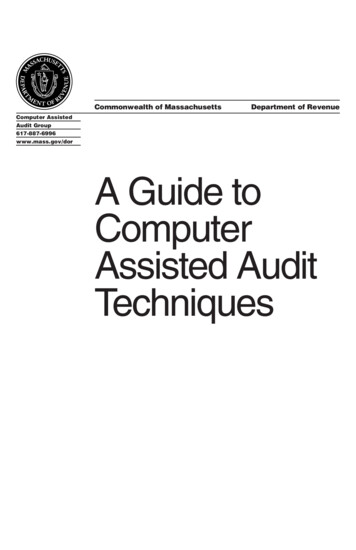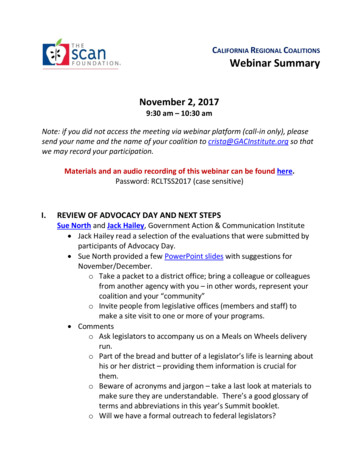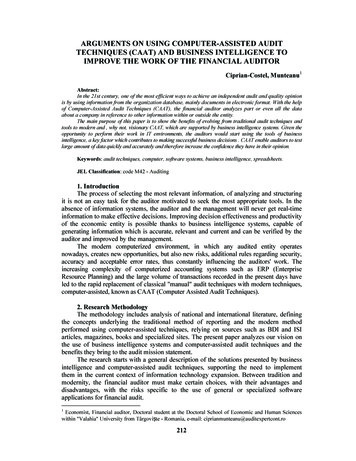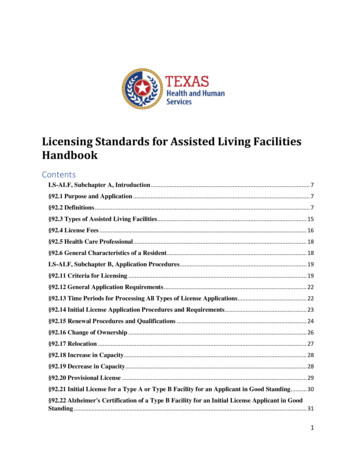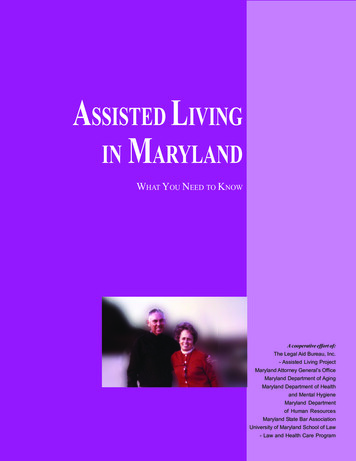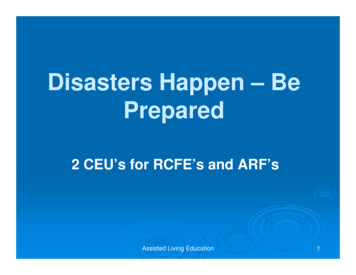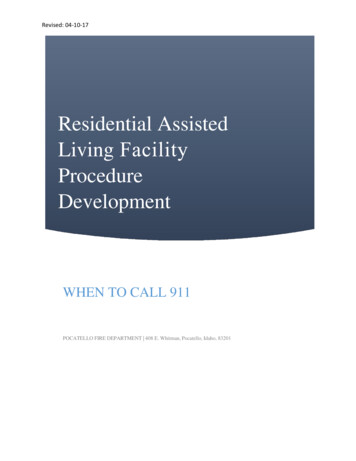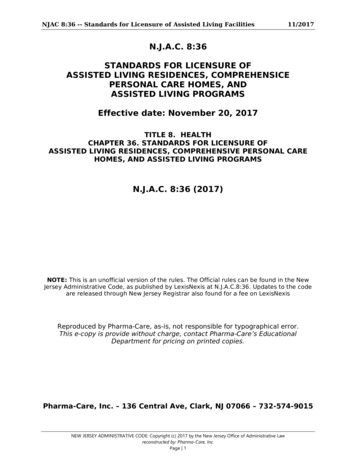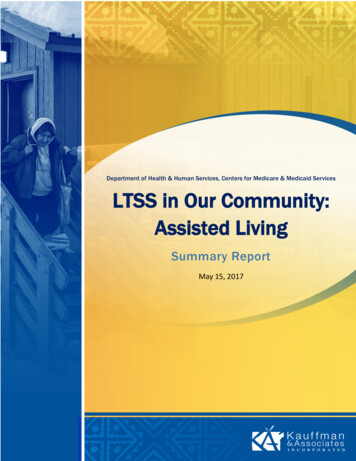
Transcription
Department of Health & Human Services, Centers for Medicare & Medicaid ServicesLTSS in Our Community:Assisted LivingSummary ReportMay 15, 2017
LTSS in Our Community: Assisted LivingSummary ReportContentsIntroduction. 3Beginning the Conversation for Long-Term Care Need . 4Assisted Living Program Development . 4Building Development and Sustainability . 4State Licensing, Medicaid Certification, and Regulations . 6Resident Payment Policy . 6Program Staff and Training . 7Cultural Considerations . 8Conclusion . 9Bibliography . 10Edith Kassanoid Gordon Assisted Living Center . 11Program Description . 11Successful Strategies . 11Resident Rates . 11Staffing . 12Staff Training . 12Cultural Considerations. 12Future Considerations . 12Pueblo of Isleta Assisted Living Facility. 13Program Development . 13Successful Strategies . 13Resident Funding . 13Facility Services . 14Cultural Considerations. 14Lesson Learned . 14Future Considerations . 14Yukon Koyukuk Elder Assisted Living Center . 15Program Description . 15Successful Strategies . 151
LTSS in Our Community: Assisted LivingSummary ReportFunding Streams . 15Assisted Living Acceptance . 16Staff & Training . 16Cultural Considerations. 16This publication was supported by GS-00F-0012S/HHSM-500-2016-00065G awarded by the Centers of Medicare &Medicaid Services. The opinions, findings, conclusions, and recommendations expressed in this publication are thoseof the authors and do not necessarily represent the official position or policies of the Department of Health andHuman Services or the Centers for Medicare & Medicaid Services.2
LTSS in Our Community: Assisted LivingSummary ReportIntroductionThe AI/AN elder population is growing at a rate twice that of the general U.S. population, reaching 2million by 2060 (Boccuti, et al., 2014). A growing elder population, along with an increased lifeexpectancy, in Indian Country has tribal communities looking to address the growing need for long-termcare (Aldrich, 2008). Conversations about providing long-term care for elders have already begun inmany communities. However, overcoming barriers, such as poor access to services and transportation,cultural insensitivity by providers, lack of education or awareness of available services, low number ofprofessional caregivers, and/or funding, need continued resolve (Smyer, et al. 2007).Long-term care has a range of service and support options for individuals that can be provided in thehome or in the community, including congregate meals, adult day care, senior housing, or nursing home,for assistance with daily activities, whether they are medical, personal, or social (Aldrich, 2008; Centerfor Medicare & Medicaid Services (CMS) TTAG & Johns, 2009). Assisted living facilities are long-termcare options that many tribes opt for to provide services and care to their communities’ elders andindividuals with disabilities. Assisted living facilities provide residents who need assistance with activitiesof daily living with private living spaces and shared communal areas, in contrast nursing homes provideincreased medical care and 24-hour care by licensed professionals (CMS, 2009).Tribal communities will approach their provision of long-term care and support differently.Understanding the community’s care needs is critical in determining what level of services or supportsare required to assist their elders or individuals with disabilities while maintaining their quality of life,independence, and dignity (Aldrich, 2008). For the Comanche Nation of Oklahoma, the Pueblo of Isleta,and the Yukon Koyukuk Elder Assisted Living Consortium of Tribes in Alaska, addressing their elders’needs meant developing their own assisted living facilities. Kauffman & Associates, Inc., interviewedeach tribe’s assisted living facility administrator about the development of their facility— the EdithKassanoid Gordon Assisted Living Center (EKGALC) in Lawton, OK; the Pubelo of Isleta Assisted LivingFacility (PIALF) in Isleta, NM; and the Yukon Koyukuk Elder Assisted Living Center (YKEALC) in Galena, AK.Each administrator noted that their community began discussing the need for long-term care yearsbefore construction started. All three communities conducted a survey with the communities and eldersto determine care needs. This document provides a summary account of these communities’ stories indeveloping their assisted living facilities from the initial discussions to development with lessons learnedfrom the process.3
LTSS in Our Community: Assisted LivingSummary ReportBeginning the Conversation for Long-Term Care NeedFor the Comanche Nation of Oklahoma, Pueblo of Isleta, and the Yukon Koyukuk Elder Assisted LivingConsortium (Nulato Tribe, Louden Tribe, Native Tribe of Koyukuk, Ruby Tribe, and Kaltag Tribe), theneed for long-term care services to support elders in their communities were identified decades beforeconstruction started. Initial discussions about developing long-term care services took place duringcommunity meetings where attendees introduced the following concerns regarding aging and elders. Elders taking care of elders – When an elder provides care for another elder, their health maybe declining as rapidly as the health of the person they care for, as is often seen when a siblingtakes care of another sibling.Increased life expectancy – With increased life expectancy, people are living longer and requiremore care.Elders leaving the community for care – Elders had to move away from the community toreceive needed care (Abeita, 2017).Following the initial recognition of the need for long-term care, the tribes and consortium needed todetermine their specific communities’ needs. They each conducted either a needs assessment to gaugecommunity interest and benefits to community or a feasibility analysis to determine if the constructionof a building was an option. Each community was initially interested in developing a nursing home;however, due to a rigorous state licensing process, an assisted living facility was the best alternative toaddress the needs of the community.Assisted Living Program DevelopmentOnce each community approved the concept for the assisted living program, the tribes and consortiumlaunched four concurrent development phases. These phases comprise: (1) acquiring funding forbuilding development and sustainability, (2) acquiring licensing and certification, (3) developing residentpayment policies, and (4) hiring and training staff. Each tribe approached these phases differently basedon their tribe’s resources and community needs.Building Development and SustainabilityAfter the community and tribe approved the concept of developing an assisted living facility for theircommunity, the tribes and consortium then had to secure resources to design and construct thebuilding. The Comanche Nation of Oklahoma, Pueblo of Isleta, and the Yukon Koyukuk Elder AssistedLiving Consortium each approached this phase differently. Table I outlines each community’sdevelopment resources, including those accessed for their facilities’ construction.4
LTSS in Our Community: Assisted LivingSummary ReportTable I. Assisted Living Facility ApproachesAssisted LivingFacilityPueblo of IsletaAssisted LivingFacilityOwnershipTriballyowned andoperatedIsleta, NMOpened 201520 RoomsYukon KoyukukElder AssistedLiving CenterGalena, AKOpened 20139 RoomsEdith KassanoidGordon AssistedLiving CenterCertificationsState license,memorandum ofagreementFederal grantPrivate payTribeTribal supplementNew buildingState licenseMedicaidConsortiumMedicaidTribal HousingAuthorityState grantState programsupplementPrivate payTriballyowned porary licenseTribalconsortium,nonprofitstatusResident PaymentState licenseLawton, OKOpened 20149 RoomsNew Market TaxCreditDonationsNew buildingPrivate payFully funded by tribeTribal supplementUpgraded existingbuildingIn each case, the tribe or consortium put forth funds for development, including construction. For theEKGALC, the tribe fully funded the project and upgraded an existing building to house the facility. Forthe PIALF, the tribe secured a federal grant that covered construction costs for the assisted living facilityand a senior center. For the YKEALC, the consortium found it challenging to secure funding for thebuilding development. However, the consortium used a myriad of funding sources and qualified to applyfor various grants, given their nonprofit status, for the building’s initial construction.The YKEALC noted that a critical piece of the development phase was to design the building withsustainability in mind. As the YKEALC administrator described, “the more elaborate and expensive yourbuilding is, the higher the insurance will be.” Along with costs to replace and repair appliances,furnishings, etc., and undergo regular inspections and upgrades, general maintenance adds up. YKEALCqualified for the New Market Tax Credit program, a program that draws private investments toqualifying organizations in exchange for tax credit. The financial support offered by the program wasused critical to upgrade the building’s energy systems in 2014. For anyone looking to develop their own5
LTSS in Our Community: Assisted LivingSummary Reportfacility, the YKEALC administrator advises they determine the cost of sustaining the building from theoutset.State Licensing, Medicaid Certification, and RegulationsAfter acquiring funding to develop a sustainable building, the tribes and consortium developed programpolicies and determined which licenses and certifications they needed to operate their facilities. Theyalso had to determine how the residents would pay for their services. The tribes and consortium found itimportant to establish relationships with the state health department offices during this process, asseveral aspects of program development require state oversight, especially when the program is lookingfor Medicaid reimbursements.The EKGALC, PIALF, and YKEALC found the state licensing process lengthy. The PIALF hired a consultantto help them acquire a state license. The PIALF was also interested in Medicaid certification, theirprocess for which is reflected in Figure 1.Figure 1. PIALF’s Medicaid Certification alProcess Prove the programcan operate untilMeidcaidreimbursmentsbegin Submit buildingplans and financialcriteria to the state Regularly meet withstate healthdepartment, lifeand safetyinspectors, andcontractors to passinspection This stage can belengthy, but theprogram canreceive a temporarylicense in themeantimeCertification Recevie Medicaidnumber Report annually tothe state officeEach phase of the process requires concurrence with the state and assurance that the regulations arebeing met, beginning with pre-construction when building plans and financial criteria are submitted tothe state for review. During construction, life and safety inspectors ensure that regulations codes arebeing met. After construction, the approval process continues, but a temporary license can be issued, aswas the case for the PIALF. Once approved, the facility will be issued a Medicaid number and mustsubmit annual reporting data to the state Medicaid office. Each program’s licensing is listed in Table I onpage 5.Resident Payment PolicyThe development of the resident payment policy is another critical phase of program development, asthis policy dictates how services are paid. For the EKGALC, PIALF, and YKEALC, resident policy was6
LTSS in Our Community: Assisted LivingSummary Reportdecided based on a determination of service versus business. First, the programs determined the cost oftheir care, followed by resident rates.The EKGALC primarily uses gaming revenue to cover costs for the care of its residents. The EKGALC thenhave the residents pay as they are able. The EKGALC administrator added, “So, we do have some rentalrevenue from residents. It doesn’t really cover a whole lot of the expense . The main purpose of thefacility was to have it here for our tribe.”In determining their cost of care, the PIALF considered that each resident would have different needsthat require different levels of care. However, the PIALF decided that a base rate would best inform theresident rate. Compared to other facilities in the area, PIALF’s base rate is considerably low. Injustification of their rate, the PIALF administrator said, “we wanted to make sure that we are making it[as] affordable as we could for our elders,” since many do not qualify for Medicaid and need to privatelypay.The YKEALC conducted outreach to the community to educate them about the program and how ithandles payment for services. To determine how a resident will pay for their care, first, the YKEALCdetermines the resident’s level of care. Then, the resident is assessed for qualification for assistanceprograms through either the State General Relief program or Medicaid. If the resident is not qualifiedfor assistance, that resident will have to pay privately. It took time for the community to adjust to theidea that their personal savings may be needed to cover their care.Each program tries to provide the best quality of life for their community and keep members close tohome and family. However, facilities must maintain regulations and policies that permit affordable carethrough Medicaid reimbursement, state relief programs, third party insurance, or private pay. Thechallenge is finding a balance between the tribe’s intent, community needs, and state regulationrequirements. Each community has a different approach and set of resources to accomplish this goal.Program Staff and TrainingThe EKGALC, PIALF, and YKEALC approach staffing and training needs similarly. For the most part, theyrecruited local staff through tribal employment or education programs. Each program identified acommon health concern among its residents and works to provide their staff with the training they needto address these concerns in their care for provision. Further, each program closely follows staterequirements for new hire training and the continued education of its staff.The EKGALC worked with the tribal job placement program and educational programs to recruit staff towork at the facility. The tribe sponsored classes for nurses’ aides and sent several tribal members toschool to receive needed education. Based on the community’s greatest health concern, diabetes, theydeveloped staffing shifts that would best fit its residents’ needs. These shifts required the EKGALC tohire enough licensed practical nurses to staff every shift. For the continued education of its staff, thefacility also holds monthly trainings that coincide with payday. For these trainings, facility staff review7
LTSS in Our Community: Assisted LivingSummary Reportmaterial on various topics on which they are then quizzed. The facility also works with the local IndianHealth Service to provide in-person trainings.At the YKEALC, the consortium set aside funding for staff training. Onboarding new staff includes 3 daysof on-the-job training; orientation to the building and regulations; and resident care. Also, included intraining are CPR, first aid, and training on dementia diseases. The facility is also interested in providingresiliency training for staff to boost their ability to overcome challenges in the work environment. Theadministrator is also establishing a formal staff evaluation process.Each facility took pride in its ability to staff local tribal members. These staff introduce importantcultural considerations for the facilities’ residents. They understand the cultural needs of their residents,speak the language of the elders, and may even know their residents’ families. This helps create anenvironment in which their residents feel at ease and at home.Cultural ConsiderationsThe EKGALC, PIALF, and YKEALC developed their visions to include the community, which determinedhow culture tied into their program and the care of their residents. Culture is at the heart of each ofthese assisted living facilities. They incorporate traditions in the residents’ daily lives through food,activities, and end-of-life considerations.Hiring local staff who understand their communities’ traditions and speak a shared language withresidents was a key component of the facilities’ staffing decisions. They further incorporate culture bydesigning daily activities and meals that incorporate traditions. Menus include local and traditionalfoods and are reviewed by a dietician and nutritionist. For instance, the YKEALC has local hunters andfishermen bring food for the elders, like moose, beaver, and salmon. The PIALF started chili pepper potsthat residents can harvest for meals like beans and green chili or chili stew.For these communities, the assisted living facility is a community hub. Activities that incorporate othercommunity members help keep the culture vibrant for the residents. For instance, the EKGALCconnected with the EKGALC daycare so children can come and sing with the elders. Elders attendcommunity events like powwows and enjoy regalia-making classes. The residents determine many ofthe facility’s activities.Overall, the facilities discovered that state and federal regulations did not hinder cultural and traditionalpractices as they originally thought might happen. Further, state contacts even encouraged the facilitiesto incorporate traditions and practices into the daily lives of the residents. The tribes and consortiumalso facilitated great partnership opportunities by including the community into their planning processand vision development, which enabled the facilities to become community hubs as an added benefitfor their residents.8
LTSS in Our Community: Assisted LivingSummary ReportConclusionThe EKGALC, PIALF, and YKEALC each opened their assisted living programs within the last 5 years,starting in 2013. Each facility ran into their own challenges during development, and establishedcommunity, and state partnerships that were beneficial. Recommendations for other tribes to considerwhen developing an assisted living facilities in their communities include: Research state and federal license requirements;Establish relationships with state departments and organizations;Build and use your community, state, and national network groups; andEstablish a vision, mission, and policies for the facility early in the planning process (Abeita,2017).Each tribe and the consortium committed to providing long-term care because the need and communitysupport were there. After the communities’ initial commitment, it took time, research, planning, andnetworking to establish the assisted living facilities. Now each of these communities has a place wheretheir elders can turn to seek long-term care without moving away from home. They can live in a placethat is sensitive to their cultural needs and keeps them connected to their communities. Further, thefacility employs local people and keeps generations connected—parents, children, and grandchildren—which allows the residents to continue giving back to the community.9
LTSS in Our Community: Assisted LivingSummary ReportBibliographyAbeita, N. (2017). Interview.Aldrich, N. (2008). Caregiving in Indian Country: Tribes Supporting Family Traditions. NationalAssociation of Chronic Disease Directors. Retrieved g/resource/resmgr/healthy aging critical issues brief/ha cib indiancaregiving.pdf?hhSearchTerms %22caregiving and indian and country%22Boccuti, C., Swoope, C., & Artiga, S. (2014). The Role of Medicare and the Indian Health Service forAmerican Indians and Alaska Natives: Health, Access and Coverage. The Henry J. Kaiser FamilyFoundation. Retrieved from own, C. M., & Gibbons, J. L. (2008). Taking Care of our elders: an initial study of an assisted-livingfacility for American Indians. Journal of Applied Gerontology, 27(4), CMS TTAG & Johns, J. L. (2009). An Overview of Long-Term Care in Indian Country. National IndianHealth Board. Retrieved from ploads/2013/LTC Overview Report 1 15 09.pdfLewis, M. (2017). Interview.Smyer, T., & Stenvig, T. E. (2007). Health care for American Indian Elders: an overview of culturalinfluences and policy issues. Home Health Care Management & Practice, 20(1), eetsir, A. (2017). Interview.
LTSS in Our Community: Assisted LivingProgram Profile of the Edith Kassanoid GordonAssisted Living CenterEdith Kassanoid Gordon Assisted Living Center“It’s been in progress for 10 years and started with tribal members themselves asking.”– Melanie Lewis, Administrator, Edith KassanoidGordon Assisted Living CenterProgram DescriptionThe Edith Kassanoid Gordon Assisted Living Center istribally owned and operated by the Comanche Nationof Oklahoma. The center provides long-term servicesand supports to its residents, including activities ofdaily living. The center provides medicationadministration, personal care, transportation, meals,activities, and housekeeping. Center staff identifieddiabetes as the most common health concern amongtheir residents and designed services to address it.The center’s development began with tribalmembers’ interest in a long-term care facility. Oncethe tribe decided to build an assisted living center,the tribal business council and tribal membersapproved the project. Establishment of the centerwith fully supported by the tribe’s gaming revenues.Successful StrategiesCenter staff have seen success in their efforts todetermine rates, recruit and train staff, andincorporate cultural into their care.Resident RatesThe center bases resident rates on income, whichamounts to a monthly rent. Typically, residentincome comes from Social Security benefits. TheComanche Nation has a low-income subsidy programthat supports residents housing rates. Private pay isalso accepted by the facility.Operated by: Comanche NationOpened: October 2014Total Rooms: 9 roomsContact Information:Melanie Lewis1001 SE 36th St.Lawton, OK e:www.comanchenation.comCommunity: Edith KassanoidGordon Assisted Living Centerserves elders aged 65 and older.The average resident age at thecenter is currently 85 years.
LTSS in Our Community: Assisted LivingProgram Profile of the Edith Kassanoid GordonAssisted Living CenterStaffing“They know all the details about what ourThe center worked with the tribal job assistanceresidents need, their personalities and beingprogram and educational programs to recruit staffwilling to step up and say ‘I’m going to do thisfor the center. The tribe sponsored classes for nursefor them, I’m going to do that.’ So, it’s not justaides and sent several tribal members to school toa job to them, they’re providing a service toreceive needed education. Because thetheir community, that they are helping theircommunity’s greatest health concern is diabetes,own people.the center developed staffing shifts to best fit theneeds of its residents who have diabetes. This shift– Melanie Lewis on staff commitmentschedule ensures that licensed practical nurses staffevery shift, particularly to address the needs ofinsulin-dependent residents. This staffing schedule also meets Oklahoma regulations for treatingpatients with diabetes. The center also hired certified nursing assistants to provide personal care.“Look at population needs. Knowwhat’s there and how those needsbump against state regulations.Each [state’s] regulations aredifferent. They need to be awareof requirements and elder needs.Then try to see what’s doable inthe planning.”– Melanie Lewis on developmentconsiderations for other tribesThe center has 20 staff, half of whom are nurses, followedby CNAs, a receptionist, a maintenance team,housekeeping, dietary staff that includes cooks and acertified dietary manager, an activities manager, andcontract staff. Contract staff include a registered nurseconsultant, dietician, medical doctor, and consultantpharmacist.Staff TrainingEmployee’s must meet Oklahoma State licensingrequirements for training before their first day. The centerholds monthly trainings that coincide with pay days.Employees review material on various topics and are thenquizzed on the material. The center also works with thelocal Indian Health Service to provide in-person trainings.Cultural ConsiderationsCulture is the heart of the center. The center incorporates traditions in the elders’ daily lives throughfood, activities, and end-of-life considerations. For instance, the center connects with the Comanchedaycare, and children come and sing with the elders. Elders attend community events, like powwows,and enjoy regalia-making classes. The residents determine many of the center’s activities.Future ConsiderationsThe community is looking to expand the center’s functions. Options include having other tribal programshoused at the center, like independent living, an elder nutrition center, or daycare services.12
LTSS in Our Community: Assisted LivingProgram Profile of the Pueblo of IsletaAssisted Living CenterPueblo of Isleta Assisted Living Facility“They are our elders. We want to give them quality care, quality of life. That’s our standard.They deserve the best care we can provide them.”– Natalie Abeita, Administrator, Pueblo of Isleta Assisted Living FacilityProgram DevelopmentPueblo of Isleta’s long-term care facility had been inthe making for almost 60 years. Efforts began withdiscussions that shared the pueblo’s hope to lightencaregiver burden for its families and keep elders inthe community. Pueblo of Isleta identified grantfunding in early 2000 to construct the assisted livingbuilding. The tribe also conducted a communitysurvey to determine their community’s need andlevels of support. These efforts resulted in tribaladministration approval to develop the facility.Operated by: Pueblo of IsletaOpened: October 2015Contact Information:Natalie
May 15, 2017 · however, due to a rigorous state licensing process, an assisted living facility was the best alternative to address the needs of the community. Assisted Living Program Development . Once each community approved the concept for the assisted living program, the tribes an
